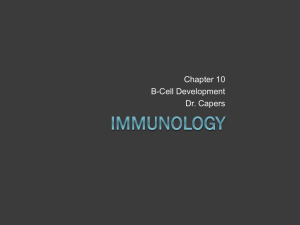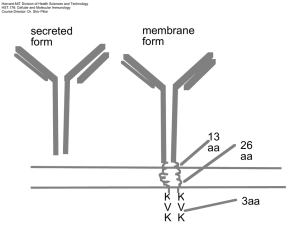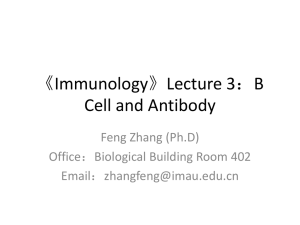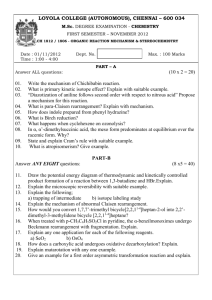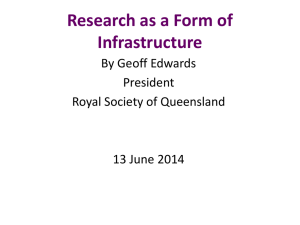Harvard-MIT Division of Health Sciences and Technology
advertisement
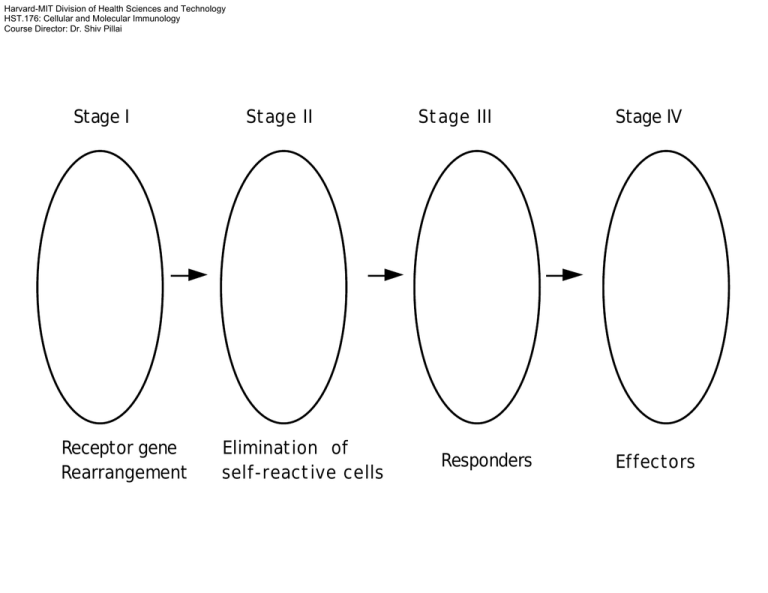
Harvard-MIT Division of Health Sciences and Technology HST.176: Cellular and Molecular Immunology Course Director: Dr. Shiv Pillai Stage I Receptor gene Rearrangement Stage II Elimination of self-reactive cells Stage III Responders Stage IV Effectors YY 3. BCR MEDIATED MAINTENANCE FOLLICLE Y SPLEEN 2. BCR MEDIATED EMIGRATION 1. pre-BCR MEDIATED POSITIVE SELECTION BONE MARROW Ψ IgM pre-BCR Y IgD YY Early pro-B Intermediate pro-B Late pro-B Large pre-B Small pre-B Immature B Mature B A B C C' D E F DH to JH rearrangement VH to DJH rearrangement VL to JL rearrangement Negative selection and Receptor editing Positive selection I Pre-B receptor dependent Positive selection II XLA Syk KO µKO Pre-pro B A Pro-B I B Pro-B2/preB C PERIPHERY Ψ C' Large pre-B V to DJ out of frame DY Small Pre-B Y E Immature B Y Y F Mature B Pre-B receptor expressing cells proliferate and allelically exclude VDJ+ In-frame C' HSC Large pre-B VDJ+ In-frame IL-7 SDF-1 Common lymphoid progenitor A pre-pro-B IL-7 SDF-1 IL-7 D-JH V-DJH B C pro-B pro/pre-B C' Large pre-B VDJ+ In-frame C' Large pre-B VDJ+ In-frame VDJVDJ- C' Large pre-B Commitment T B Positive selection I Allelic exclusion Positive selection II Negative selection Transcriptional regulation of early lymphoid development Tcf-1-/- Gata-3-/- DN DP SP Ikaros-/- CLP E2a-/Sox-4-/- PU.1-/- PreB ProB Ebf-/Pax-5-/- B Entry versus commitment • Commitment implies irreversibility and in wild type B cells has occurred when Ig H-chain gene rearrangement is initiated • Certain transcription factors such as EBF and E2A are required to turn on genes required early in B cell development • In the absence of Pax-5 cells “enter” the B lineage but remain highly plastic Pre-B receptor B cell receptor ι/vpreB ω/λ5 Ig β ITAM Syk Blk/Lyn/Fyn (Src family kinases) Other signaling pathways Ig β Ig α ITAM Syk Blk/Lyn/Fyn/Fgr (Src family kinases) Btk (Bruton's tyrosine kinase) Defective in X-linked agammaglobulinemia) Ig α Other signaling pathways Btk ι/vpreB ω/λ5 Ig β Syk Blk/Lyn/Fyn Ig α ITAM Btk 1)Survival 2) Proliferation 3) Allelic exclusion 4) Induction of κ rearrangement 5) Shut off of surrogate light chain expression B cell tolerance See Immunobiology, by Janeway,C., Travers, P., Walport, M. and Capra, J., Garland Publishing, 5th edition, 2001 & Cellular and Molecular Immunology by Abbas, A., Pober, J., and Lichtman, A., W B Saunders; 4th edition. RECEPTOR EDITING Rag gene reexpression Deletion of old V κ-Jκ rearrangement New κ or λ lightchain CLONAL DELETION BCR signals induce caspase activation Apoptotic death Multivalent Paucivalent OR ANERGY Chronic crosslinking model Ca++ influx seen but not sustained NFAT and ERK activated normally NFκB and JNK NOT activated Red Pulp White pulp B marginal zone and marginal sinus T B µ L VDJ Poly A sites δ Poly A sites AAAA Unspliced IgD message Cap site ATG mRNA for IgD heavy chain AAAA AAAA mRNA for IgM heavy chain monosaccharide polysaccharide antigen receptor NO SIGNAL SIGNAL TRANSDUCTION Microbial antigens Bacterial LPS Y B-1 ? Microbial antigens IgM HSC Fetal Liver HSC pro-B/ pre-B No TdT Limited diversity YY IgD B B cells with bias towards multivalent TI-1 antigens Y B-1 Y B-1 B-1 cells are self-renewing and express CD5 The B-1/CD5 B "lineage" THREE DISTINCT TYPES OF PERIPHERAL B LYMPHOCYTES CD21 HIGH Y IgM SPLEEN CD1 PERITONEUM / MUCOSAL SITES B-1 B CELLs MARGINAL ZONE B CELLS IgM FOLLICULAR B CELLS IgM IgD YY CD21 Y CD5 MZ and Follicular B cells See Immunobiology, by Janeway,C., Travers, P., Walport, M. and Capra, J., Garland Publishing, 5th edition, 2001 & Cellular and Molecular Immunology by Abbas, A., Pober, J., and Lichtman, A., W B Saunders; 4th edition. Are only “chosen” B cells selected by endogenous antigens? OR Do all B cells get tickled via the antigen receptor ? Other pathways Other pathways Other pathways Mutation Signal Strength BCR BCR "No BCR signals" Btk Btk PLCγ2 PKCβ MZ FO B-1 - - - "Weak BCR signals" + - - PLCγ2 "Weak BCR signals" +* - - PKCβ " Weak and Intermediate BCR signals" + + - None "Weak, Intermediate, and Strong BCR signals" + + + LONG-LIVED PERIPHERAL B CELL POPULATIONS Strong BCR Signals …….B-1 cells Intermediate strength BCR signals…….Follicular B cells Relatively weak BCR signals …..MZ B cells CD21 CD1 Y MZ B CELLS Newly formed B cells Y IgD IgM YY FI FII Y SPLEEN IgD FOLLICLE FIII NF BCR MEDIATED EMIGRATION pre-BCR MEDIATED POSITIVE SELECTION BONE MARROW Ψ IgM pre-BCR Y Early pro-B Intermediate pro-B Late pro-B Large pre-B Small pre-B Immature B A B C C' D E DH to JH rearrangement VH to DJH rearrangement VL to JL rearrangement IgD ? Y Mature B F activated TCR T CD4 gp 39/CD40L YBCR CD40 MHC class II (loaded) Y B T cell areas follicle (B cell zone) Cortex Medulla artery afferent lymphatics vein efferent lymphatic 1.Dendritic cells (interdigitating) in T cell zones 2. Follicular dendritic cells in B cell areas 3. Macrophages everywhere Focal aggregate 2 Red pulp Ag X Y I B White pulp T Y Y 3 Germinal center 4 TB T somatic mutation isotype switching high affinity T cell Memory B cells low affinity APC Plasma cells X ?Receptor diversification and rescue Follicular Dendritic cell Activation of APCs via CD40 to release IL-12 and drive a TH1 type response T activated gp 39/CD40L ?Signals to T cell CD40 TCR CD4 gp 39/CD40L YBCR CD40 MHC class II (loaded) Y B Required for T-dependent immune responses -proliferation -class switching -germinal center formation -somatic mutation CD40L mutations lead to X-linked hyper-IgM syndrome PALS (T cell area) Follicle ( B cell area) Light zone Dark zone } Germinal center memory B cells plasma cells Centroblasts Centrocytes apoptosis V gene hypermutation JH Cµ Cδ Cγ3 Cγ1 Cα1 Cγ2 Cγ4 Cε Cα2 VDJ Sµ Cµ Cδ Sγ3 Cγ3 Sγ1 Cγ1 Sα Cα γ2b, γ2a and ε Cγ3 Sγ3 Sγ1 Cδ Cγ1 Cµ Looping out and deletion VDJ Sµ Sα VDJ Sα Cα Cα Switched to IgA Switch regions and I-region promoters V DJ C Cα3'E iENH µ Iµ Sµ δ γ2b, γ2a and ε C regions unspliced pre-MRNA Iµ Sµ Iµ µ 3'αE Iα Sα Iγ3 Sγ3 µ α γ3 HS3B spliced Iµ transcript HS4 LCR Class Switching (Murine) 1. IL-4 promotes switching to IgG1 and IgE 2. TGF- β promotes switching to IgA 3. γ-IFN promotes switching to IgG2a Somatic mutation-I 1. Point substitutions. Non-templated single base changes in rearranged H- and L-chain V region genes 2. Requires T cell help, occurs in centrocytes 3. 10-4 to 10-3 base pairs/generation 4. Bell shaped curve of mutations starts in leader intron and ends about 1.5 kb downstream 5. Hotspot motifs 6. Transitions more common than transversions SOMATIC MUTATION -II 7. Requires enhancer 8. Mechanism:AID DEPENDENT DNA DEAMINATION a. Cytosines converted to uracils b. Replication or error prone repair generates mutations 9. Accessibility? ? Need for transcription?? AID required for both class switching and somatic mutation • AID is a novel Activation induced cytidine deaminase • Related to a protein involved in RNA editing • Required for class switching and also for somatic mutation • Aid-/- mice have large germinal centers • Humans lacking AID present with hyper IgM syndrome YY 3. BCR MEDIATED MAINTENANCE FOLLICLE Y SPLEEN 2. BCR MEDIATED EMIGRATION 1. pre-BCR MEDIATED POSITIVE SELECTION BONE MARROW Ψ IgM pre-BCR Y IgD YY Early pro-B Intermediate pro-B Late pro-B Large pre-B Small pre-B Immature B Mature B A B C C' D E F DH to JH rearrangement VH to DJH rearrangement VL to JL rearrangement For more information and examples, see Immunobiology, by Janeway,C., Travers, P., Walport, M. and Capra, J., Garland Publishing, 5th edition, 2001 & Cellular and Molecular Immunology by Abbas, A., Pober, J., and Lichtman, A., W B Saunders; 4th edition.
